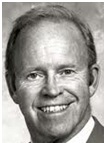|
 |
|
 |
|
|
||
Philip Crosby (1926-2001)
American quality expert whose book Quality Is Free (see below) gave him global acclaim (pictured right).
Key book
Quality Is Free (1979)
Quality must become a way of life, being an integral part of an organization's corporate culture. This requires accepting the five “absolutes” of quality management:
1. Quality means conformance to requirements.
2. Responsibility for quality must be shared by everyone from the top down, not just by quality control specialists.
3. Quality is achieved through prevention of problems (not inspection) and doing it right first time.
4. The only quality standard is zero defects.
5. Quality is measured by the cost of doing things wrong
“Quality is free”, because the costs of poor quality (defects, customer complaints, inspection, extra after-sales service etc) are very high (at least a quarter of sales revenue).
There are 14 steps in the quality improvement process:
Key quotes on quality Quality comes from prevention, not detection. Quality is free. But it is not a gift. The quality process goes on forever. Measurement is very important. People like to see results. Getting people to do better all the worthwhile things that they ought to be doing anyway (how to make quality certain) |
|
|
||
|
|
||
| Copyright © wisdomtowin.com 2025 All Rights Reserved | ||
|



